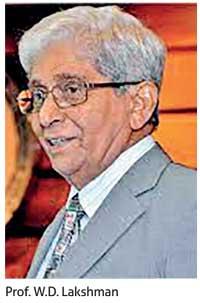Reply To:
Name - Reply Comment
The Monetary Board yesterday raised policy interest rates, ending its unprecedented monetary support extended to the pandemic-hit economy in a bid to address recent external sector imbalances and ward off medium term price pressures to make sure the economy is on track to record 5.0 percent growth this year.
 Accordingly, the Monetary Board which met on Wednesday for the sixth time for the year to decide on the trajectory of the interest rates, raised the benchmark Standing Deposit Facility Rate (SDFR) and the Standing Lending Facility Rate (SLFR) by 50 basis points (bps) each to 5.0 percent and 6.0 percent respectively, ending the more than two-year long easing cycle.
Accordingly, the Monetary Board which met on Wednesday for the sixth time for the year to decide on the trajectory of the interest rates, raised the benchmark Standing Deposit Facility Rate (SDFR) and the Standing Lending Facility Rate (SLFR) by 50 basis points (bps) each to 5.0 percent and 6.0 percent respectively, ending the more than two-year long easing cycle.
In addition, the rate setting committee also raised banks’ statutory reserve ratio by 2.0 percentage points to 4.0 percent effective from September 1, 2021, requiring licensed commercial banks to keep 4.0 percent of their deposits with the Central Bank, from an earlier 2.0 percent requirement.
“The Board expects these monetary policy decisions to iron out the prevailing imbalances in the domestic financial markets and the external sector of the economy, while preempting the buildup of any excessive inflationary pressures over the medium term, thereby supporting greater macroeconomic stability,” the statement issued by the Monetary Board said.
The shift in the monetary policy stance came amid the consensus that had built up among the analyst community for the Central Bank to pause any near-term inclinations towards raising rates considering the shadow casted over the economy due to the virus resurgence.
The about turn in policy has been prompted by the widening trade deficit, anomalies in the interest rates between rupee and dollar deposits, divergence in the dollar/rupee exchange rate offered in the formal and informal markets and the inflation, with a particular focus on the exponential rise in food prices.
But the Central Bank assured that the decisions wouldn’t affect the envisaged growth trajectory as they said the economy is on the path to recovery from a low base last year as considerable section of the economy is acclimatised to work-from-home and the vaccines being fast rolled out.
“As you are aware the growth process is on track and the economy is poised to record a growth of around 5.0 percent in 2021,” said Central Bank Governor Prof. W.D. Lakshman addressing a virtual press conference held yesterday.
The Sri Lankan economy contracted by 3.6 percent in 2020 due to pandemic-induced lockdowns.
The rate setting committee doesn’t think the hike in the bank reserve ratio to slow the credit flows to the private sector as the upwards adjustment in deposit rates would attract large amount of currency in circulation into the banking sector, which can then be channeled into the needy segment of the economy. The Central Bank said it achieved the desired outcomes from the monetary stimulus unleashed since the onset of the pandemic last year as seen from the high frequency indicators such as the acceleration in private sector credit growth and the recovery in industrial activity. But in the process it generated some excesses in the macro economy by way of higher prices, which were exacerbated by the external sector weaknesses. The Central Bank since April has been saying that it wouldn’t hesitate to adjust the interest rate policy should excesses emerge or price pressures appear more persistent than transitory. With this week’s decision, Sri Lanka’s Central Bank joined a growing number of central banks around the world which have been following a similar path by way of raising interest rates or expressing their intentions to dial back their pandemic era stimuli sooner than earlier anticipated. Vast deviations from the official exchange rate by the banks and the informal channels have concerned the Monetary Board the most at their policy meeting as it created confusion and uncertainty in the markets lately.
“In terms of Central Bank’s official position, the exchange rate remains at the levels which we agreed with the banks on a gentlemen’s agreement basis, that is less than Rs.203 (for a dollar),” Professor Lakshman said.
“We are aware of the deviation from that rate, both in the formal market and also in the informal markets. We will have to expect some effect on this from the measures announced today and we are looking at further possibilities in lessening the gap,” he added hinting at the possibility of further measures to address the issue.